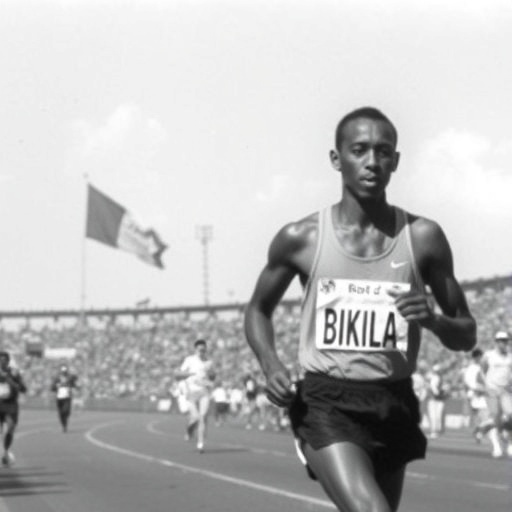Abebe Bikila‘s Unforgettable Second Olympic Marathon Triumph: Marking October 21 in Sports History
On October 21, 1964, the world witnessed a moment of pure athletic transcendence as Ethiopian runner Abebe Bikila crossed the finish line in Tokyo to claim his second consecutive Olympic marathon gold medal, solidifying his place in sports history. Barely four years after his barefoot victory in Rome, Bikila shattered the world record with a time of 2 hours, 12 minutes, and 11.2 seconds, outpacing a field of international elite runners under the humid night skies of Japan’s capital. This triumph wasn’t just a personal milestone; it highlighted the growing dominance of African athletes in track and field, inspiring generations and reshaping global perceptions of endurance sports. As we remember this iconic day, Bikila’s story intersects with standout performances by American and international stars, underscoring October 21 as a pivotal date in Olympic marathon and track and field lore.
Bikila’s win came at a time when the Olympics were expanding their reach, with the 1964 Tokyo Games marking Asia’s first hosting of the event. The marathon, traditionally the culminating spectacle, drew massive crowds and international media attention. Bikila, running in shoes for the first time at the Olympics, faced skepticism after a leg injury had sidelined him earlier that year. Yet, his resilience turned doubt into awe, finishing 25 seconds ahead of silver medalist Basil Heatley of Great Britain. This victory, on October 21, wasn’t merely a race outcome—it was a narrative of perseverance, cultural pride, and the unyielding spirit of Abebe Bikila.
Bikila’s Path from Barefoot Pioneer to Tokyo Legend
Abebe Bikila’s journey to Olympic immortality began in the rugged highlands of Ethiopia, where running was as natural as breathing. Born in 1932 in Jato, a small village, Bikila joined the Imperial Guard in Addis Ababa as a teenager, honing his skills through military training runs that spanned dozens of miles daily. His talent caught the eye of Swedish coach Onni Niskanen, who spotted him during a 1959 marathon in Addis Ababa. Under Niskanen’s guidance, Bikila transformed from a local phenom into a global contender.
The turning point arrived at the 1960 Rome Olympics. Selected as a last-minute replacement, Bikila entered the Olympic marathon barefoot—a decision born of ill-fitting shoes and a deep-rooted cultural comfort with running unshod. On a sweltering September evening, he surged past defending champion Emil Zátopek and Rhodiain Moroccan Rhadi Ben Abdesselam in the final miles, winning by a mere 25 seconds in 2:15:16.2. As he raised his arms in victory before the Arch of Constantine, Bikila became the first Black African to win an Olympic gold, a feat that electrified Ethiopia and the continent. "The victory was for my country," Bikila later reflected through an interpreter, emphasizing how his win symbolized Ethiopia’s resilience post-Italian occupation.
By 1964, Bikila was a household name, but challenges mounted. A surgery for appendicitis and a broken leg from a car accident in 1963 tested his resolve. Doctors advised retirement, yet Bikila trained relentlessly, logging up to 20 miles daily on crutches initially, then graduating to full runs. Arriving in Tokyo, he adapted to the humid climate and the marathon’s nighttime start to mitigate heat— a strategic innovation by organizers. October 21 dawned with anticipation; Bikila, now 32, lined up with 77 runners, including favorites like Ron Hill of Britain and Kokichi Tsuburaya of Japan, the local hero.
His preparation paid dividends. Bikila’s strategy was methodical: conserve energy early, then unleash in the latter stages. Drawing from his 1960 experience, he paced himself against the pack, his lithe 5-foot frame belying immense power. Historians note that Bikila’s VO2 max—estimated at over 80 ml/kg/min—placed him among the era’s fittest athletes. This section of his story, from Rome’s cobblestones to Tokyo’s illuminated streets, underscores why Abebe Bikila remains a beacon in sports history, proving that barriers of injury, expectation, and geography could be overcome through sheer will.
The Thrilling Drama of the 1964 Tokyo Marathon Unfolds
As the gun sounded at 3 p.m. local time on October 21, 1964, the Tokyo marathon transformed the city’s bustling streets into a theater of human endurance. The 26.2-mile course wound through neon-lit avenues, past the Imperial Palace, and back to the National Stadium, where 75,000 spectators awaited. Bikila, wearing Puma shoes provided by sponsor Abebe Aregai, started conservatively, shadowed by a pack led by Japan’s Tsuburaya and Ireland’s Ron Ryan. The heat, hovering at 70 degrees Fahrenheit with high humidity, claimed early victims—over 20 runners dropped out within the first 10 miles.
Mid-race drama intensified around the 15-mile mark. A leading group of 10, including Bikila, Heatley, and Japan’s Toru Terasawa, broke away. Bikila’s calm demeanor contrasted with the fraying nerves of his rivals. "I felt strong from the start, but I knew I had to wait," Bikila recounted post-race. At the 20-mile point, near the Meiji Shrine, Bikila accelerated, dropping all but Heatley and Tsuburaya. The Japanese crowd, mistaking Tsuburaya’s effort for victory, erupted prematurely—only to fall silent as Bikila pulled away decisively in the final three miles.
Crossing the line at 8:12 p.m., Bikila not only defended his title but set a new world record, eclipsing his own 1960 mark and the previous best by over three minutes. Heatley, exhausted, took silver 25 seconds later, while Tsuburaya, heartbroken on home soil, earned bronze but tragically took his own life months later, haunted by the near-miss. Statistics from the race reveal its brutality: the winning pace averaged 4:53 per mile, with Bikila burning an estimated 2,600 calories. This event on October 21 highlighted the evolution of the Olympic marathon, incorporating medical innovations like sponge stations for hydration—a response to Rome’s dehydration crises.
Beyond the leaders, the race showcased international depth. Morocco’s Rhadi, the 1960 runner-up, finished fourth, while American Kenneth Mills placed 23rd in 2:21:50, the best U.S. showing. The Tokyo marathon’s legacy includes its role in popularizing road running in Asia, with viewership exceeding 100 million worldwide via emerging TV broadcasts. For track and field enthusiasts, this race remains a masterclass in pacing and mental fortitude, forever linked to Abebe Bikila‘s name.
American and International Stars Illuminate Tokyo’s Track and Field Stage
While Bikila dominated the marathon, October 21, 1964, resonated within the broader tapestry of the Tokyo Olympics’ track and field events, where American and international athletes delivered performances that echoed through sports history. The Games, spanning October 10-24, featured 36 events at the Komazawa Olympic Park, but the marathon’s finale capped a week of U.S. excellence. Just days prior, on October 17, American Wyomia Tyus blazed to gold in the women’s 100m with a 11.4-second sprint, becoming the first repeat winner since 1948. Her victory, part of a sweep in the sprints, underscored America’s relay prowess— the 4x100m team, including Edith McGuire, clocked a world-record 44.6 seconds.
Internationally, the Soviet Union flexed muscle in field events. On October 18, Tamara Press hurled the shot put 18.14 meters for gold, her second straight Olympic win amid whispers of gender verification controversies that plagued women’s track and field. Poland’s Irena Szewińska, then 18, stunned in the 200m, edging Australia’s Betty Cuthbert— the "Golden Girl" of 1956—with a 23.1-second run. These feats built momentum toward October 21, when the marathon’s spotlight amplified the Games’ diversity.
American men shone too. Billy Mills, a Navajo runner from Kansas, orchestrated one of the greatest upsets in Olympic marathon history on October 20 in the 10,000m, surging from obscurity to gold in 28:24.4, a world record. "I ran for my people," Mills said, drawing parallels to Bikila’s cultural motivation. In the decathlon, concluded October 19, Rafer Johnson (1960 gold medalist) mentored teammate Bill Toomey to silver, while the U.S. dominated the 400m hurdles with Rex Cawley’s 49.6-second victory.
Looking beyond 1964, October 21 holds other gems in sports history. In 1956, during the Melbourne Olympics, American Mildred McDaniel leaped to high jump gold with 1.76 meters, a mark that stood as the U.S. women’s record for years. Internationally, on October 21, 1978, Boston Marathon winner Bill Rodgers defended his New York City title, bridging elite racing and mass participation. These intertwined narratives on October 21 illustrate how American grit and global talent converged in track and field, much like Bikila’s era-defining run.
- Key U.S. Achievements in Tokyo: 16 golds in athletics, including sweeps in sprints and hurdles.
- International Highlights: Australia’s Dawn Fraser in swimming parallels, but track saw Europe’s throwers dominate.
- Stats Snapshot: Over 1,000 athletes competed; U.S. won 36 total medals, second to USSR’s 38.
Bikila’s Double Gold Reshapes Global Endurance Running
Abebe Bikila’s back-to-back Olympic marathon victories profoundly influenced track and field, catalyzing the rise of East African dominance. Pre-1960, marathon podiums were European-heavy; post-Bikila, Ethiopians and Kenyans claimed 20 of 24 golds from 1968-2016. His success spurred Ethiopia’s investment in running academies, producing legends like Haile Gebrselassie and Kenenisa Bekele. "Bikila opened the door for us," Gebrselassie once said, crediting the pioneer’s barefoot ethos for inspiring high-altitude training regimens.
Tragically, Bikila’s life ended young; paralyzed in a 1969 car accident, he took up adaptive sports, winning the 1969 Armed Forces Torvil games in a wheelchair. He passed in 1973 at 41, but his legacy endures through the Abebe Bikila International Marathon in Addis Ababa, held annually since 2007. In sports history, his October 21, 1964, win symbolized decolonization’s athletic arm, as African nations gained independence and Olympic representation.
Forward-looking, Bikila’s story fuels modern initiatives. The IOC’s refugee team, debuting in Rio 2016, echoes his outsider narrative. As Paris 2024 approaches, with its marathon starting at the Eiffel Tower, organizers cite Bikila’s innovation—night racing—as inspiration for sustainable, spectator-friendly formats. Training science has evolved too; today’s elites use GPS tracking and carbon-plated shoes, yet Bikila’s raw endurance reminds us of running’s essence. Ethiopia’s current stars, like Sifan Hassan, who won 5,000m and 10,000m golds in Tokyo 2020, carry his torch, ensuring Abebe Bikila‘s impact ripples into future Olympic marathon epics. On this anniversary of October 21, his triumph invites us to celebrate not just the past, but the boundless potential of perseverance in track and field.
In an era of viral sports moments, Bikila’s quiet determination stands timeless, urging athletes worldwide to run with purpose. As climate challenges push marathons toward eco-friendly routes, his legacy adapts, proving that true champions transcend eras.









